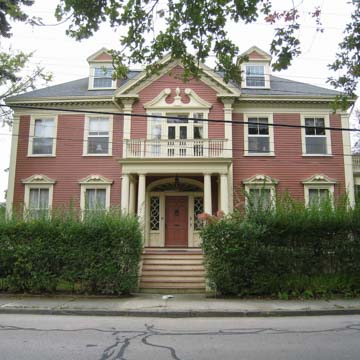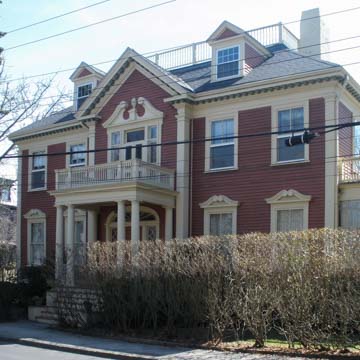Susan James Weaver was a Newport native and daughter of John Goddard Weaver, the builder and proprietor Newport’s premier Gilded Age–era hotel, the Ocean House. Weaver, who never married, was an active member of Newport’s year-round community, and she worked for Channing Chapel, on the Newport Waterworks, and with various other local groups during a career of volunteerism and philanthropy.
In 1896, Weaver purchased a lot on Kay Street, on the edge of the fashionable Kay Street/Catherine Street neighborhood, which had been developing since the 1880s, when its rural character captured the imagination of a first wave of summer residents. Weaver’s lot was proximate to the top of Bellevue Avenue, the center of Newport’s burgeoning tourist culture. Her lot was also near the Broadway corridor, where most of Newport’s year-round activities were located. It was also close to several other houses built by women, including the Stevens House and the Lieber House, erected some fifteen years earlier. Though Weaver was a late-comer to the neighborhood, she followed the lead of these earlier women and hired Dudley Newton to designer her house.
A variation on the Vassall-Longfellow House, Newton’s design is Colonial Revival with assertively academic details. At two and a half stories, the house consists of a main block with a projecting frontispiece and classical portico. The first floor contains a central entrance with an ovoid fan light and side slights with ovoid details. This entrance is recessed beneath a portico consisting of Tuscan columns supporting a balustrade. On the lower level of the main facade, windows with scrolled pediments flank the frontispiece, two to each side. These are echoed at the second story of the frontispiece, where double doors and flanking windows are surmounted by a grandly scaled broken pediment with similar scrollwork. The facade appears crowded, but each detail also has a certain prominence in the overall design. The materials are primarily wood with clapboards on the walls and carved details over the windows. Weaver lived in the house until her death in 1917 and since then, the house has remained a single-family residence.
Antoinette Downing and Vincent Scully included the Weaver House in their groundbreaking book, The Architectural Heritage of Newport, Rhode Island, but they fail to discuss the question of patronage and their assessment of the building is somewhat pejorative, describe it as representing “the true end of academicism and antiquarianism.” While later scholars have been more kind to the Weaver House, a more nuanced view of the design is overdue.
References
Downing, Antoinette F., and Vincent J. Scully, Jr. The Architectural Heritage of Newport, Rhode Island. Cambridge, MA: Harvard University Press, 1952.
Onorato, Ronald J. AIA Guide to Newport. Providence, RI: AIA RI Architectural Forum, 2007.
Yarnall, James L. Newport through its Architecture: A History of Styles from Postmedieval to Postmodernism. Newport: Salve Regina University Press, 2005.




